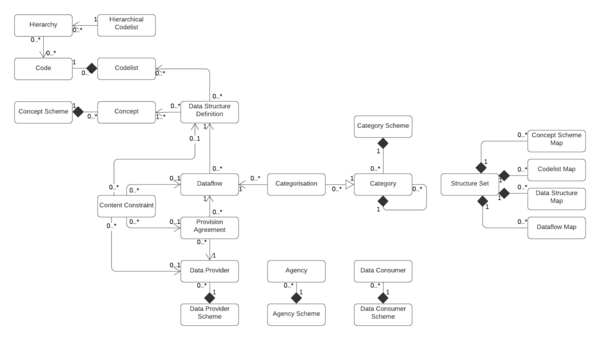Difference between revisions of "SDMX Information Model V10"
(Created page with "Category:FMR_Concepts_Reference To be written.") |
|||
| (34 intermediate revisions by 2 users not shown) | |||
| Line 1: | Line 1: | ||
| − | [[Category: | + | [[Category:Concepts_Reference_V10]] |
| + | The '''SDMX Information Model''' is a standardised object model for modelling statistical domains centring on the structure of their datasets, the coding schemes used for classifying series, and the rules for controlling the exchange of data between organisations. The model also allows for the definition of various business rules including those for checking data quality and transforming datasets’ to different structures and classification schemes. Means of categorising and indexing the data available are provided to help end-users such as statisticians discover the datasets and series they need. | ||
| + | When implementing statistical systems based on the SDMX standard, this ‘structural metadata’ can be used to drive all stages of the data lifecycle from reporting, collection, validation and transformation through to dissemination. | ||
| + | |||
| − | + | [[File:SDMX Model.png|600px]] | |
| + | |||
| + | |||
| + | The SDMX 2.1 model consists of around 17 [[Maintainable V10|Maintaible]] artefacts such as the Codelist and Data Structure Definition plus other [[Identifiable V10|Identifiable]] structures such as Code and Concept. | ||
| + | |||
| + | The [Dataflow]] is a pivotal object in the SDMX Information Model: it describes specific data sets and is the construct for which data is both reported against and disseminated against. It makes use of the structural information defined by the Data Structure Definition but allows further restrictions to be specified for the allowable content using [[Content Constraint|Content Constraints]]. | ||
| + | |||
| + | The [[Data Structure Definition V10|Data Structure Definition]] is also fundamental defining the structure of one or more data sets in terms of their [[Dimension|dimensions]], [[Attribute|attributes]] and [[Measure V10|measures]]. | ||
| + | |||
| + | The [[Data Provision Agreement]] contains information about the supply of data by one [[Data Provider|Data Provider]] for one Dataflow. In a data collection environment it can contain a link to additional constraints that further restrict the allowed values that can be reported by a Data Provider. In a Data Dissemination environment, is can link to a Registered Data Source that identifies the location of the data - usually the URL of a SDMX data file or SDMX data web service. | ||
| + | |||
| + | Each Dataflow can be connected to one or more [[Category Scheme V10|Categories]] and similarly a Category can link to multiple dataflows. These connections support data discovery by organised topics such as Demography, Census, Health, Finance. | ||
| + | |||
| + | The model includes a small number of artefacts such as '''Process''' and '''Reporting Taxonomy''' which are rarely used in practice and, for this reason, are not shown on the schematic. | ||
Latest revision as of 07:25, 17 April 2024
The SDMX Information Model is a standardised object model for modelling statistical domains centring on the structure of their datasets, the coding schemes used for classifying series, and the rules for controlling the exchange of data between organisations. The model also allows for the definition of various business rules including those for checking data quality and transforming datasets’ to different structures and classification schemes. Means of categorising and indexing the data available are provided to help end-users such as statisticians discover the datasets and series they need.
When implementing statistical systems based on the SDMX standard, this ‘structural metadata’ can be used to drive all stages of the data lifecycle from reporting, collection, validation and transformation through to dissemination.
The SDMX 2.1 model consists of around 17 Maintaible artefacts such as the Codelist and Data Structure Definition plus other Identifiable structures such as Code and Concept.
The [Dataflow]] is a pivotal object in the SDMX Information Model: it describes specific data sets and is the construct for which data is both reported against and disseminated against. It makes use of the structural information defined by the Data Structure Definition but allows further restrictions to be specified for the allowable content using Content Constraints.
The Data Structure Definition is also fundamental defining the structure of one or more data sets in terms of their dimensions, attributes and measures.
The Data Provision Agreement contains information about the supply of data by one Data Provider for one Dataflow. In a data collection environment it can contain a link to additional constraints that further restrict the allowed values that can be reported by a Data Provider. In a Data Dissemination environment, is can link to a Registered Data Source that identifies the location of the data - usually the URL of a SDMX data file or SDMX data web service.
Each Dataflow can be connected to one or more Categories and similarly a Category can link to multiple dataflows. These connections support data discovery by organised topics such as Demography, Census, Health, Finance.
The model includes a small number of artefacts such as Process and Reporting Taxonomy which are rarely used in practice and, for this reason, are not shown on the schematic.
